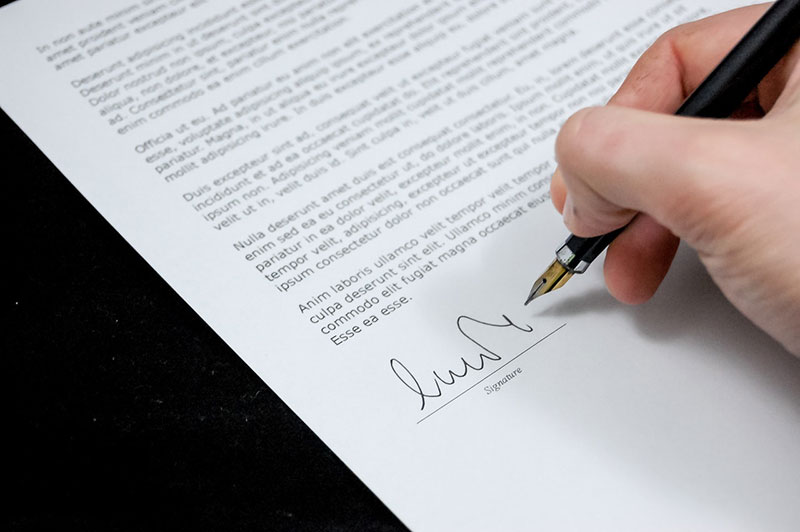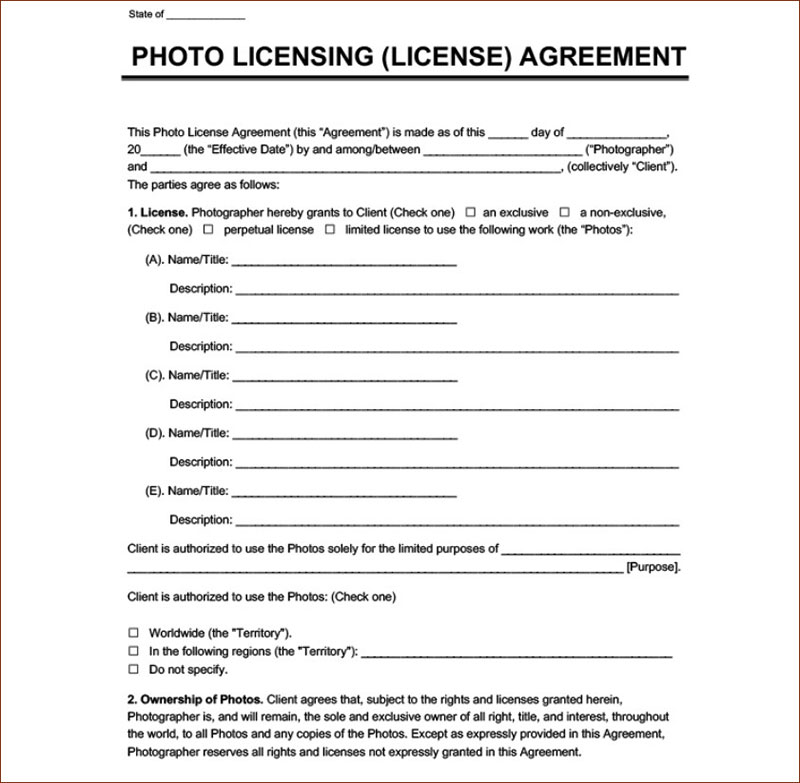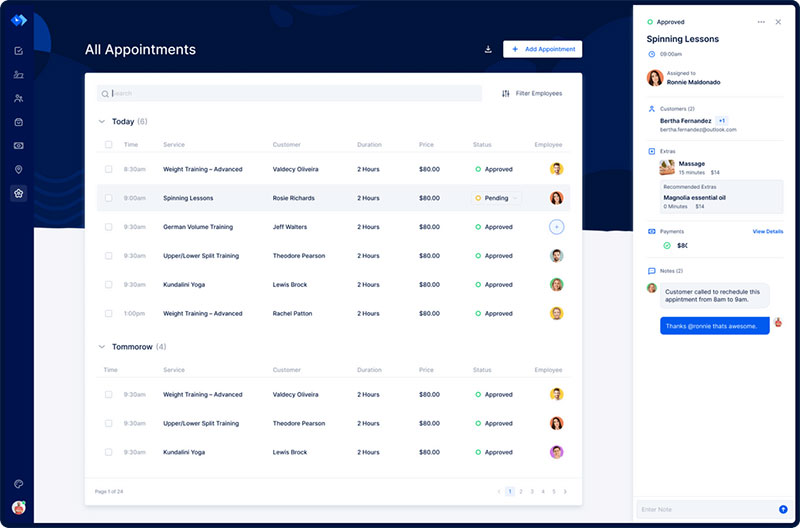The goal of any professional photographer is to make money with photography services. It is also possible to earn extra by licensing images for specific purposes.
If buyers work in a commercial or editorial sector, it is recommended to have a photo licensing agreement between both parties. Such an agreement specifies in which ways it is permissible to use the sold images.
Photo licensing agreements are very common, and there is a whole range of specific ones available. Some have strict terms, and others allow more freedom.
This article contains all relevant aspects to writing up a license agreement.
What Image Licensing Entails

People that photograph new images have creative rights to them. But they can permit others to use them and decide for how long. The photographer outlines conditions to their use in a photo licensing agreement.
Amongst other things, it may say whether the client can use the pictures for commercial purposes, like advertisements. It can also include who has the right to the photos, how long, and if the maker can resell them when the client no longer uses them.
Thus, put in simple terms, a license is a contract between a photographer and a client. It limits the way the client can use the pictures after acquiring them. The client can only use the image in ways that fall within the scope of the licensing agreement.
A photo licensing agreement typically involves two parties. First, there is the copyright owner, the photographer. This party is the licensor. And second, there is the one who wants certain rights to the image, the licensee.
Instead of using the images himself, a licensee may also receive the right to subcontract the rights. In that case, the licensee becomes the licensor in a second agreement.
A photo license agreement does not imply the sale of the copyright. It is the right to use the photos that the licensor extends under specified conditions. The licensee does not own the copyright.
Independent photographers own the copyrights to their pictures as soon as they take them. It is different for photographers that work under contract for a company. Then the pictures' copyrights usually belong to the company.
There are two ways for clients to get licensed photographs:
- Assignment photography. The client hires the services of a photographer to create new images.
- Stock photography. This option is much cheaper than the first one. The client obtains the license for existing photographs.
Thus, assignment photography is simply a service where the photographer creates requested images. Stock pictures are more like a commodity. The licensing of stock photographs is big business, and a few large companies dominate the industry. These companies have their own ways of doing business.
The Benefits of a Licensing Agreement
A photo license agreement protects both the copyright holder and the client who wants to use the photo. The agreement details which images the client can use, how to use them, and whether the client can modify them.
The fact that photographers have copyrights to their pictures does not mean that they will automatically receive income. The person can charge money for the shoot and negotiate additional fees. Generating money through a license agreement is possible only if the photographer keeps the rights to the pictures.
Another way is when another company comes across an image on the internet. The company can approach the copyright holder to request to use it for its purposes.
It is up to the photographer to decide how much to charge for the license. There is no specific rule for how much it should be. Yet, there should always be an amount involved. Companies that use an image for an advertisement campaign can make a lot of money from it.
There are a few things to consider when determining how much to ask. Here are some:
- Will the client use the photograph only in print or also online?
- What is the scope of the campaign?
- For how long will the advertisement run?
Besides these considerations is the usual day rate or creative fee. This fee is a payment for the time and energy invested in creating and preparing the shoot and the use of equipment. The photo licensing fee is like renting a picture.
Get more bookings with the right tool for the job
Staying organized has never been easier.
You can now manage your business and grow your brand with a single, powerful software that keeps all of your appointments in line, your clients organized and your business booming.
Trafft is perfect for business owners who need to streamline their booking experience both for their staff and their clients.
Trafft handles everything for you, even sending automated email or SMS reminders to your clients. No-shows? Not anymore!
The Trafft booking software adapts to different industries for a blissful online booking experience and employee management.
Want to know more? Check out Trafft's awesome features to see what you are missing.
Helping the Client
The photographer's clients are not always familiar with the way photo licensing agreements work. A licensee may need help understanding the contract.
Larger companies usually employ experts who know how to handle legal issues. Small companies, on the other hand, do not. So, as a photographer, it is important to be familiar with the practical and legal aspects. That also helps the client.
It helps to keep both parties happy if the terms are clear in a written agreement. Then all involved know what to expect from the transaction.
The agreement is particularly beneficial for photographers that work with first-time clients. First-timers do not always understand the concept of usage rights. They may think that they now own the image and can do whatever they want with it. Yet, there is a difference between the right to use a photo and the copyright. The agreement helps the client to understand that difference.
Clients who acquire the right to use an image often connect the image with their brand. For them, it would be terrible if others, especially their competition, use the same image. For that reason, they may request an exclusive agreement.
Exclusivity means that no one else can use the image. The copyright owner can not license the same photo to another client or use it as a stock photo. Often, there is an additional fee involved for obtaining exclusive rights. Because of this, exclusive photo licensing fees can be much higher.
What to Regulate With a Photo License Agreement

As mentioned in the introduction, there are many different kinds of licensing agreements. These are some examples of various categories:
- Retail. This is not a very common condition. It usually applies to pictures for personal use, like wedding pictures. The client obtains the pictures on a commission basis. The maker of the photos keeps the copyright, but the client gets the right to reproduce them for personal use.
- Commercial. The client uses the photographs for commercial purposes. Think of advertisements, brochures, or other marketing tools. The agreement should specify the commercial intent.
- Editorial. The primary intent is not commercial. The client uses the image in a post or an article.
The three categories differ in the purpose for which the client wants the right to use the image. There is no difference in the quality of the pictures or how famous or talented the photographer is.
Retail, commercial, and editorial agreements have specific details and priorities. Often they differ in pricing structures as well. Yet, in all cases, the copyright stays with the maker of the photos.
What to Include in a Photo Licensing Agreement

A photo licensing agreement should always be put in writing, without exception. If it is not clearly written, the contract relies on witnesses. And depending on the interests of the witnesses, they may explain the oral agreement in the way that suits them best.
Some photo licensing agreements are rather simple; others are very complicated. That depends on the circumstances and parties involved. But here are some terms that should be in any agreement:
- The parties. Like in any legal contract, the agreement must be very clear about the licensor, licensee, and third parties, if applicable. Use the correct legal personal or company names.
- A list of licensed photographs. The list should include a description of the images. It is wise to include copies of the photos as well.
- Type of usage rights. Is the agreement exclusive or non-exclusive? Exclusive rights imply that clients can use the image in any way they see fit. Non-exclusive rights mean that a client can only use the images in the manner stipulated in the agreement. The specified intent of the use should be part of this too.
- The fee. This includes the total amount that the client will pay. Royalties per sold image may apply too. Penalties for late fees or interest must also be explicitly agreed on.
- Permissions. This term details how, when, and where the client can use the photographs. Formats of use include printed and electronic. Other restrictions could apply to the area in which the client can use the image. The licensor can also grant non-commercial rights only.
- Contents, duration, and spatial modalities. The term of the agreement is not always indefinite. The licensor can also limit the place and setting in which the client can use the image.
- Rights to edit. The copyright holder can decide whether the client can modify the image.
FAQs about having a photo licensing agreement
1. What is a photo licensing agreement?
A picture license agreement is a written contract between the photographer and the person using the image that specifies the conditions of usage, limitations, and costs related to using the image. It permits the photographer to keep ownership of the image while giving the user permission to use it for a certain function.
2. What are the benefits of having a photo licensing agreement?
A photo licensing agreement makes sure that the user and the photographer agree on the intended usage of the image. It makes the terms and conditions of use more clear, aids in avoiding legal problems, and makes sure the photographer is paid for their efforts.
3. What types of photos can be licensed?
Any photograph that was taken by the photographer and is unique can be licensed. Photographs of people, places, structures, and things fall under this category.
4. How does a photo licensing agreement differ from copyright?
A photo license agreement is a contract that specifies how a photograph may be used. Contrarily, copyright is a legal privilege that guards the original photographer against unauthorized use or reproduction of their work.
5. How long does a photo licensing agreement last?
A photo license deal will normally state how long it will last. It may be a one-time use or a long-term arrangement that permits numerous uses over a predetermined amount of time.
6. What are the restrictions on the use of licensed photos?
The photo licensing agreement outlines the limitations on how licensed images may be used. These may include limitations on the kind of use, the time frame for use, the image size or resolution, and the geographic area in which the image may be used.
7. Can I modify a licensed photo?
A licensed image normally cannot be altered without the photographer's consent. The terms and conditions for any adjustments or modifications to the photo will be specified in the photo license agreement.
8. How much does it cost to license a photo?
Many variables, including the intended purpose of the image, its size and resolution, and the length of the license, might affect how much it costs to license a particular image.
Before utilizing the image, make sure the license fee is fairly priced and agreed upon.
9. What happens if I use a licensed photo without permission?
A violation of the contract and potential legal action by the photographer can come from using a licensed image without authorization.
This may entail a request for payment, the withdrawal of the image from publication, or even monetary compensation for the photographer's losses.
10. Do I need a lawyer to create a photo licensing agreement?
Even while hiring a lawyer to draft a photo license agreement isn't always essential, it can be useful to get legal counsel to make sure that the terms and conditions are reasonable and safeguard the interests of both parties.
To prevent future arguments and legal problems, it's crucial to establish a detailed and binding agreement.
Ending thoughts on photo licensing agreements
Licensing photographs is a very good way for a photographer to create income. Although this applies to a lesser extent to retail photographers, it is big money for editorial and commercial photographers. Still, all photographers should have a library of photos that they can license.
Photo licensing agreements involve artistic, business, and legal skills. For some, the whole licensing aspect is overwhelming. But with practice, it gets easier, and there are many resources available. Hopefully, this article is one of these.
So, always have a photo licensing agreement ready for any shoot. In the end, it will save money and a lot of trouble.
If you enjoyed reading this article on photo licensing agreements, you should also read this one about real estate photography marketing.
We also wrote articles about similar subjects like photography mini-sessions, pricing photography prints, becoming an event photographer, how to become a licensed photographer, social media marketing for photographers, real estate photography contract, appointment scheduling for real estate agents, how to get your photography noticed and photography mood board.







